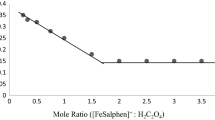Abstract
The kinetics of the intra-molecular electron transfer of an adduct of l-ascorbic acid and the [Fe III3 O(CH3COO)6(H2O)3]+ cation in aqueous acetate buffer was studied spectrophotometrically, over the ranges 2.55 ≤ pH ≤ 3.74, 20.0 ≤ θ ≤ 35.0 °C, at an ionic strength of 0.50 and 1.0 mol dm−3 (NaClO4). The reaction of l-ascorbic acid and the complex cation involves the rapid formation of an adduct species followed by a slower reduction in the iron centres through consecutive one-electron transfer processes. The final product of the reaction is aqueous iron(II) in acetate buffer. The proposed mechanism involves the triaqua and diaqua-hydroxo species of the complex cation, both of which form adducts with l-ascorbic acid. At 25 °C, the equilibrium constant for the adduct formation was found to be 86 ± 15 and 5.8 ± 0.2 dm3 mol−1 for the triaqua and diaqua-hydroxo species, respectively. The kinetic parameters derived from the rate expression have been found to be: k 0 = (1.12 ± 0.02) × 10−2 s−1 for the combined spontaneous decomposition and k 1 = (4.47 ± 0.06) × 10−2 s−1 (ΔH ‡1 = 51.0 ± 2.3 kJ mol−1, ΔS ‡1 = −100 ± 8 J K−1 mol−1), k 2 = (4.79 ± 0.38) × 10−1 s−1 (ΔH ‡2 = 76.5 ± 0.8 kJ mol−1, ΔS ‡2 = 6 ± 3 J K−1 mol−1) for the triaqua and diaqua-hydoxo species, respectively.










Similar content being viewed by others
Notes
John Cousins & Laurence Herbert, TgK Scientific Limited, UK.
Carboxylate based buffers are best suited for this system, as other buffers such as citrate, PO4 3− or dimethylglutaric acid, reacted with the complex as evidenced in the UV/Vis spectra.
STAGRAPHICS Centurion XV, StatPoint Inc., Warrenton, Virginia 20186, USA.
Unpublished work.
Abbreviations
- Trimer:
-
[Fe III3 O(CH3COO)6(H2O)3]+
References
Bond AM, Clark RJH, Humphrey DG, Panayiotopoulos P, Skelton BW, White AH (1998) J Chem Soc Dalton Trans 1998:1845–1852
Stadler C, Daub J, Kohler J, Saalfrank RW, Coropceanu V, Schunemann V, Ober C, Trautwein AX, Parker SF, Poyraz M, Inomata T, Cannon RD (2001) J Chem Soc Dalton Trans 2001:3373–3383
Sowrey FE, MacDonald CJ, Cannon RD (1998) J Chem Soc Faraday Trans 94(11):1571–1574
Manchanda R (1996) Inorg Chim Acta 245:91–95
Ito S, Inoue K, Mastumoto M (1982) J Am Chem Soc 104:6450–6452
White RP, Stride JA, Bollen SK, Chai Sa-Ard N, Kearly GJ, Jayasooriya UA, Cannon RD (1993) J Am Chem Soc 115:7778–7782
Oh SM, Hendrickson DN, Hassett KL, Davis RE (1984) J Am Chem Soc 106:7984–7985
Jang HG, Geib SJ, Kaneko Y, Nakano M, Sorai M, Rheingold AL, Montez B, Hendrickson DN (1989) J Am Chem Soc 111:173–186
Oh SM, Wilson SR, Hendrickson DN, Woehler SE, Witterbort RJ, Inniss D, Strouse CE (1987) J Am Chem Soc 109:1073–1090
Pelizzetti E, Mentasti E, Pramauro E (1978) Inorg Chem 17(5):1181–1186
Dixon DA, Sadler NP, Dasgupta TP (1993) J Chem Soc Dalton Trans 1993:3489–3495
Beckford FA, Dasgupta TP, Geoffrey Stedman G (1995) J Chem Soc Dalton Trans 1995:2561–2563
Dixon DA, Sadler NP, Dasgupta TP (1995) Transition Met Chem 20(3):295–299
Abdur-Rashid K, Dasgupta TP, Burgess J (1996) J Chem Soc Dalton Trans 1996:1393–1398
Abdur-Rashid K, Dasgupta TP, Burgess J (1996) J Chem Soc Dalton Trans 1996:1385–1391
Creutz C (1981) Inorg Chem 20:4449–4452
Kagayama N, Sekiguchi M, Inada Y, Takagi HD, Fuahashi S (1994) Inorg Chem 33:1881–1885
Sisley MJ, Jordan RB (1992) Inorg Chem 31:2137–2143
Maragh PT, Thomas SE, Dasgupta TP (2005) Inorg Chim Acta 358:3610–3616
Lawrence MAW, Maragh PT, Dasgupta TP (2010) J Coord Chem 63(14):2517–2527
Dawson RMC, Elliott DC, Elliott WH, Jones KM (eds) (1969) Data for biochemical research, 2nd edn. Oxford University Press, Oxford
Dziiobkowski CT, Wrobleski JT, Brown JT (1981) Inorg Chem 20(3):671–678
Fujihara T, Aonahata J, Kumakura S, Nagasawa A, Murakami K, Ito T (1998) Inorg Chem 37:3779–3784
Abe M, Tanaka M, Umakoshi K, Sasaki Y (1999) Inorg Chem 38:4146–4148
Spiccia L, Stoeckli-Evans H, Marty W, Giovanoli R (1987) Inorg Chem 26:474–482
Flynn CM (1984) Chem Rev 84:31–41
Roe JH, Kuether CA (1943) J Biol Chem 147:399–407
Roe JH, Oesterling MJ (1994) J Biol Chem 152:511–517
Xu J, Jordan RB (1990) Inorg Chem 29:4180–4184
Bhattacharyya J, Das S, Mukhopadhyay S (2007) J Chem Soc Dalton Trans 2007:1214–1220
Keypour H, Silver J, Wilson MT, Hamed MY (1986) Inorg Chim Acta 125:97–106
Martinez P, Zuluaga J, Uribe D, van Eldik R (1987) Inorg Chim Acta 136:11–16
Bansch B, Martinez P, Uribe D, Zuluaga J, van Eldik R (1991) Inorg Chem 30:4555–4559
Martinez P, Zuluaga J, Kraft J, van Eldik R (1988) Inorg Chim Acta 146:9–12
Merbach AE (1982) Pure Appl Chem 54(8):1479–1493
Vrubel H, Hasegawa T, de Oliviera E, Nunes FS (2006) Inorg Chem Comm 9:208–211
Uemura S, Spencer A, Wilkinson G (1973) J Chem Soc Dalton Trans 1973:2565–2571
Bard AJ, Faulkner LR (1980) Electrochemical methods fundamentals and applications. Wiley, New York
Marcus RA (1968) Electrochim Acta 13:995–1004
Borsook H, Davenport HW, Jeffreys CEP, Warner RC (1937) J Biol Chem 117:237–279
Jordon RB (2007) Reaction mechanism of inorganic and organometallic systems, 3rd edn. Oxford University Press, USA
Acknowedgements
The authors would like to thank Professor Willem H. Mulder and Dr. Novelette Sadler-McKnight for their valuable comments to this work, and The University of the West Indies (Mona) Board of Graduate Studies & Research for funding.
Author information
Authors and Affiliations
Corresponding author
Electronic supplementary material
Below is the link to the electronic supplementary material.
Rights and permissions
About this article
Cite this article
Lawrence, M.A.W., Thomas, S.E., Maragh, P.T. et al. Mechanistic studies on the intramolecular electron transfer in an adduct species of the oxo-centred trinuclear iron(III) cation and l-ascorbic acid in aqueous solution. Transition Met Chem 36, 553–563 (2011). https://doi.org/10.1007/s11243-011-9502-2
Received:
Accepted:
Published:
Issue Date:
DOI: https://doi.org/10.1007/s11243-011-9502-2




